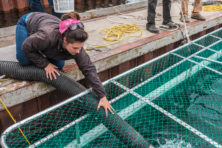The Wandering Chinook
- Share
- Tweet
- Pin
- Share
On July 10, 2014, an angler fishing out of Baileys Harbor caught a 32-inch, 13.2-pound male Chinook salmon that had been stocked in May 2012 in Lake Huron from the Cheboygan River in northeastern Michigan.
That may not mean anything to the angler, but it’s important information for Great Lakes fishery biologists, who were able to tell where the fish originated thanks to the four-year-old Great Lakes Mass Marking Project.
In 2011, the U.S. Fish & Wildlife Service teamed up with state fishery managers to begin tagging all Chinook salmon stocked in Lake Michigan and the U.S. waters of Lake Huron. A tiny coded wire tag is inserted into the snouts of the salmon before they leave the fishery. Since the wire tags are too small to be recognized by anglers, the small adipose fin is removed from each salmon’s back so anglers know when they have caught a tagged fish.
Once a tagged fish has been identified, the second part of the program known as “headhunters” kicks in.
U.S. Fish & Wildlife and DNR staff man larger ports to collect data on catches, and drop-off locations have been set up at other locations, such as Baileys Harbor.
But the anglers in Gills Rock went an extra step by collecting and freezing Chinook heads for pickup by the DNR.
“We target most of our headhunter efforts at the bigger ports,” said DNR fisheries biologist Nick Legler. “We send our staff out to bigger ports because they can get potentially bigger samples. So for northeastern Wisconsin we spend most of our efforts sampling Two Rivers, Manitowoc, Kewaunee, Algoma and Sturgeon Bay. As a result, some of the smaller ports we don’t get to. So in addition to our efforts, we have this volunteer return program. The anglers up in Gills Rock really did an awesome job for us. They collected a ton of samples and got us some really good information on their fishery. For those samples particularly, what we were interested in seeing, where did those stocked fish come from?”
That was an important question to answer for the biologists and the anglers of Gills Rock, who lobbied the DNR to begin stocking Chinook in Gills Rock again, which the DNR began to do in the spring of 2014 with 30,000 young Chinook deposited into net pens before being released. Another 30,000 were stocked this spring.
“There were some thoughts by some of the anglers up there that they were catching Northern Door-stocked fish,” Legler said. “What the results showed us was that really the anglers up there are similar to what we are seeing elsewhere in the lake. They are catching fish stocked all over the place by all the different states, as well as fish coming from Lake Huron. That’s probably the most important piece of information we were able to get from those fish.”
The Gills Rock anglers collected a total of 322 tagged Chinook, most of which were caught from Gills Rock, but a few, such as the Lake Huron-stocked fish mentioned above, were caught elsewhere, such as Baileys Harbor or Washington Island. They were collected from June 24, 2014, through Sept. 13, 2014.
The tagged Chinook collected in Gills Rock included 29 fish from Illinois (nine percent), 13 fish from Indiana (four percent), 61 fish from Michigan waters of Lake Huron (19 percent), 64 fish from Michigan waters of Lake Michigan (20 percent), and 155 fish from Wisconsin (48 percent).
“In the summer, they’re probably following different temperatures and water currents and closely following the bait fish all across the lake,” Legler said. “As we move closer to fall, stocking locations, particularly in Wisconsin, become more important, because those mature fish return to stocking locations to spawn.”

